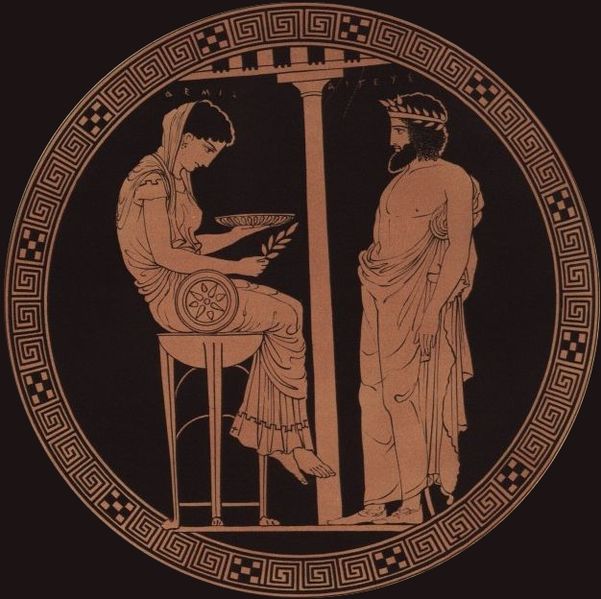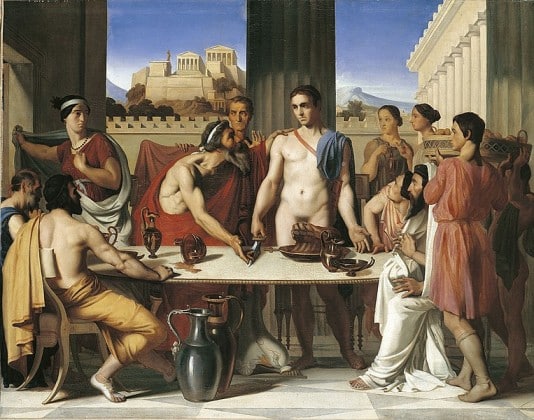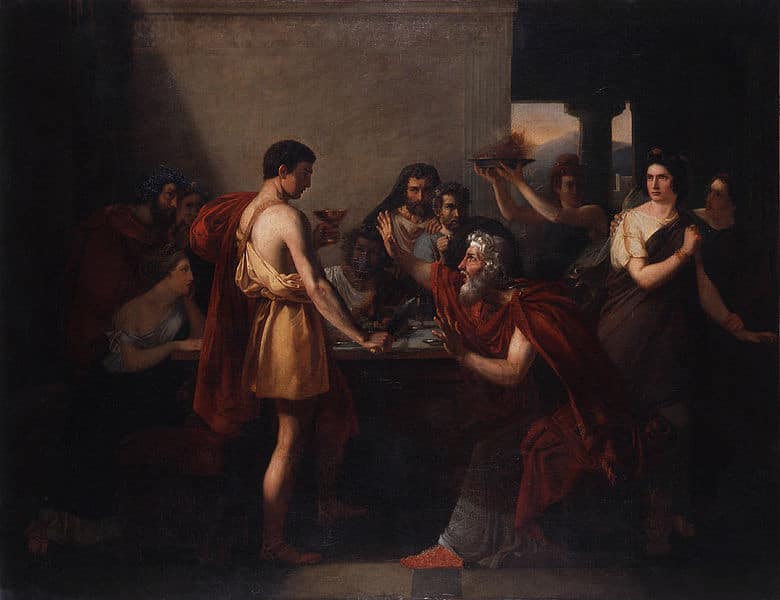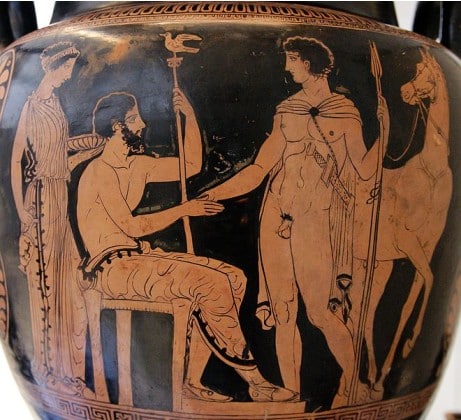In the vast realm of Greek mythology, Aegeus holds a distinctive yet often overlooked position. His tale, nestled within the intricate web of heroic sagas and divine interventions, unveils a narrative rich with love, despair, and a touch of the inevitable Greek tragedy. Aegeus, the King of Athens, is not merely a character in the grand narrative but a bridge between the mortal realm and the divine, his lineage intertwined with the whims of gods and the fates of heroes.
The tale of Aegeus unfolds in a time when gods walked among men, and heroes rose to challenge the natural and the supernatural. His narrative is a blend of human endeavor and divine orchestration, a tale that reflects the essence of Greek mythology.
Aegeus Key Facts
| Keyword | Fact |
|---|---|
| Parents | Pandion II and Pylia |
| Partners | Aethra |
| Siblings | Nisus, Lycus, Pallas |
| Offspring | Theseus |
| Other names | N/A |
| Roman name | Aegeus |
| Best Known Myth | Father of Theseus, and his tragic end |
Name and Etymology
The name Aegeus, like many ancient Greek names, carries a tale of its own. It’s believed to be derived from the Greek word “Aiges,” meaning “goat.” This etymology hints at the rustic, pastoral culture from which the ancient Athenian monarchy emerged. The name also resonates with the rugged terrain of Greece, embodying the spirit of survival and resilience that marked the era.

In the Roman rendition, Aegeus retains his name, a nod to the significance of his character in the broader narrative of ancient lore. Unlike many of his contemporaries, Aegeus didn’t bear a different name in Roman mythology, a testament to his unique standing in the annals of mythic history.
The epithets and other names associated with Aegeus are scarce, which is a reflection of his somewhat overshadowed legacy amidst the luminous stars of Greek mythology. His tale, though poignant, often gets eclipsed by the grandeur of other heroes and gods, rendering him a quieter echo in the vast chorus of ancient tales.
Aegeus Family and Relationships
Aegeus was born to Pandion II and Pylia, a lineage of nobility and divine favor, alongside his siblings Nisus, Lycus, and Pallas. His birth, like those of his brothers and many heroes and kings of that era, was enveloped in a shroud of divine intervention and royal intrigue. The lineage from which Aegeus and his siblings descended was one that would, in time, intertwine with the destinies of gods and heroes alike.

His love life was marked by a significant relationship with Aethra, who bore him a son, Theseus. This union was not just a melding of hearts but a fusion of destinies that would ripple through the annals of Greek mythology. The tale of Aegeus and Aethra is one of love, loss, and the inexorable pull of fate, a narrative that embodies the quintessence of Greek romantic tragedies.
Aegeus’s childhood and early years are shrouded in the mists of time, with scant details emerging from the ancient texts. However, his later life, especially his relationship with his son Theseus, unveils a narrative rich with paternal love, royal duty, and the tragic miscommunication that often marks the Greek tales.
Myths about Aegeus
Aegeus’s story is a fascinating one, filled with love, intrigue, and the kind of drama that Greek myths are famous for.
Aethra’s Tale
Aethra was not just a fleeting love interest in Aegeus’s life; she was the mother of his famous son, Theseus. Aegeus met Aethra in Troezen, where he was visiting King Pittheus, Aethra’s father. Following a night together, orchestrated by Pittheus to ensure the continuation of Aegeus’s lineage, Aethra became pregnant with Theseus. Aegeus, unaware of the pregnancy, left for Athens, but not before leaving his sword and sandals under a huge rock, instructing Aethra to send their child to him once he was strong enough to lift the rock and retrieve the items.

Aethra’s story didn’t end there. She was later captured during the war and was taken as a slave. The twists and turns in her life reflect the turbulent times she lived in, where love and war were intertwined, and personal destinies were often at the mercy of larger, unfolding historical events.
Aegeus and Medea
Now, the tale of Aegeus and Medea is quite the rollercoaster. Medea, known for her sorcery, found a safe haven in Athens with Aegeus after fleeing from Corinth. Aegeus, who was still without an heir (as he was unaware of Theseus), was promised by Medea that she could help him have children. However, things got a bit dicey when Theseus arrived in Athens. Medea recognized him as a threat to her position and her son’s inheritance, so she plotted to have him killed. Luckily, Aegeus recognized his son just in time to prevent the tragedy, showing the protective fatherly side of the Athenian king.
The Tragic End of Aegeus
The tragic end of Aegeus is a narrative imbued with the quintessence of Greek tragedy. As Theseus embarked on his perilous journey to slay the Minotaur, Aegeus, fraught with paternal concern, awaited his return on the shores of Athens. The agreement was simple; a white sail hoisted on the returning ship would signal Theseus’s success, while a black sail would bear the grim news of his demise.
The day dawned when the ship approached the shore, but alas, in the heat of victory, Theseus forgot to hoist the white sail. Aegeus, seeing the black sail, was engulfed in despair. In a moment of utter grief, he threw himself into the sea, which henceforth bore his name, the Aegean Sea.
This tale is a poignant reminder of the fragile thread that binds joy and despair, victory and loss. It’s a narrative that reflects the inexorable pull of fate, a theme that resonates through the vast tapestry of Greek mythology.
Depiction And Characteristics
His appearance, often marked by regal attire and a crown, reflects the dignity and the burden of royalty. The narrative of Aegeus is not merely a tale of a king but a reflection of the era, an era marked by the interplay of mortal endeavor and divine whims.
The symbols associated with Aegeus are few but poignant. The sword and the sandals, which he left for Theseus, are not merely objects but symbols of heritage, duty, and the inexorable pull of destiny. These symbols resonate with the larger themes of Greek mythology, where objects often bore the weight of divine design and mortal endeavor.
Aegeus’s personality, as unveiled through the ancient texts, is a blend of royal dignity, paternal love, and a touch of the tragic flaw that often marked the characters of Greek mythology. His love for Theseus, his despair at his presumed demise, and his tragic end are narratives that reflect the human essence amidst the grandeur of gods and heroes.
Representations Of Aegeus In Art
The depiction of Aegeus in ancient art is not as prolific as some other figures from Greek mythology, but he does make appearances in various forms of art, particularly in pottery and vase painting. Here are a couple of examples:
- Aegeus and the Black Sail:
- There are ancient Greek vases that depict the moment Aegeus throws himself into the sea, despairing over the black sail that he mistakenly believes signals his son Theseus’s death. This scene captures the tragic end of Aegeus and is a poignant representation of his story.
- Aegeus and Medea:
- In some ancient artworks, Aegeus is depicted with Medea, showcasing the interaction between the Athenian king and the sorceress. Their alliance and the subsequent drama involving Theseus are sometimes captured in ancient vase paintings.
These pieces of art provide a visual narrative to Aegeus’s story, encapsulating the drama and the emotions that are integral to his tale. They offer a glimpse into how the ancient Greeks visualized and interpreted the story of Aegeus, providing a tangible connection to the mythic past.
Mentions in Ancient Texts
Aegeus’s tale, like a gentle ripple, touches the shores of various ancient texts, each narrative unveiling a different facet of his character and his tale.

Ovid’s Metamorphoses
Ovid, a revered Roman poet who lived during the reign of Augustus, penned his magnum opus Metamorphoses around 8 CE. This work is a narrative poem that traverses the tales of creation to the deification of Julius Caesar. Within its verses, the narrative of Aegeus’s tragic end is told with a touch of poetic melancholy. The tale unfolds with Aegeus’s despair at the sight of the black sail, a narrative that resonates with the essence of Greek tragedy.
The excerpt, “The wretched father, making a sign to the heavens with his arms, said, ‘You are the cause of my death!’ and fell headlong into the sea, which took its name from him,” captures the essence of Aegeus’s tragic end, a narrative that echoes through the annals of time.
Plutarch’s Life of Theseus
Plutarch, an ancient Greek biographer and essayist, penned his narrative Life of Theseus around 75 CE. This work is part of his series Parallel Lives, where he juxtaposed the lives of famous Greeks and Romans. The tale unfolds with Aegeus’s recognition of his son at the crucial moment, a narrative that reflects the blend of paternal love and royal duty that marked their tale.
The excerpt, “But Aegeus, who was now very old, and had no children to succeed him, had been persuaded by the heralds of Pallas, who were then at Athens, to take their king as his adopted son,” unveils the essence of Aegeus’s tale, a narrative rich with love, duty, and the inexorable pull of fate.
Sophocles’ Aegeus
Sophocles, one of the three ancient Greek tragedians whose plays have survived into modern times, crafted a narrative around Aegeus in his play Aegeus. Though the exact date of composition is unknown, it’s believed to have been written in the 5th century BCE. This play, though now lost with only fragments remaining, likely explored the nuanced relationship between Aegeus and Theseus, and possibly Aegeus’s interactions with other figures of Greek mythology.
Euripides’ Medea
Euripides, another eminent Greek tragedian, delved into the narrative of Aegeus and Medea in his play Medea, written around 431 BCE. In this work, Aegeus provides sanctuary to Medea, showcasing a blend of compassion and political acumen. The dialogue between Aegeus and Medea unveils the complexities of their alliance and the broader political and social dynamics of the time.
The excerpt, “If with your children you should come to my house, there in my land where I am king, you shall remain, and I will never, against your will, surrender you to any man,” reflects Aegeus’s benevolent and protective nature, a narrative that adds a layer of complexity to his character in Greek mythology.
Frequently Asked Questions
Aegeus is best known as the father of the hero Theseus, and for his tragic end where, in despair, he threw himself into the sea, which henceforth was named the Aegean Sea in his honor.
Aegeus had notable relationships with Aethra, who bore him his son Theseus, and with Medea, the sorceress who found refuge in Athens under his protection.
Aegeus was a mortal, the King of Athens, whose tale is intertwined with the whims of gods and the fates of heroes, embodying the essence of Greek mythology.
Aegeus met a tragic end when he, in despair at the sight of a black sail which he thought signified his son Theseus’s death, threw himself into the sea, which was then named the Aegean Sea in his honor.
The notable symbols associated with Aegeus are the sword and sandals he left for his son Theseus, symbols of heritage, duty, and destiny in Greek mythology.
Aegeus is often depicted in a regal demeanor, with notable artwork capturing the moment of his tragic end as he plunged into the sea, a narrative that reflects the essence of Greek tragedy.
Featured Image Credit: Kodros Painter, Public domain, via Wikimedia Commons
